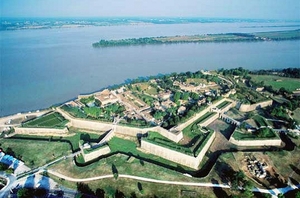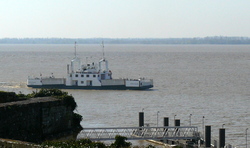 Return with me for a moment to the 17th Century, when Louis XIV, the Sun King, needs to defend Bordeaux, his prize port some 350 miles southwest of Paris, at the bottom end of Europe's longest estuary, the Gironde. He dispatches the Marquis de Vauban, a brilliant engineer and military strategist to survey the scene, and, ten days later Vauban has his design figured out.
Return with me for a moment to the 17th Century, when Louis XIV, the Sun King, needs to defend Bordeaux, his prize port some 350 miles southwest of Paris, at the bottom end of Europe's longest estuary, the Gironde. He dispatches the Marquis de Vauban, a brilliant engineer and military strategist to survey the scene, and, ten days later Vauban has his design figured out.
At Blaye, a spot 20 miles north of the city, where the estuary is still two miles wide, Vauban has 2,000 workers dig the moats, build the berms, and line them with the limestone from nearby quarries. He doesn't worry about an attack from the water but protects against a land assault; he designs a star-shaped citadel so cannons on the redoubts can provide cover for each other (Bulbous, round redoubts create blind spots.) Now, secure against attacks from the land side, he can turn his attention to the riverfront. No artillery at the time has enough range to cross the estuary, so Vauban creates two outposts, one on a tiny island and one on the opposite shore. Between them, this will become known as the "Vauban Lock," an impregnable fortress against the Spanish and the Dutch. It would hold, unchallenged, for three centuries, before passing into history.
Vauban's work is visible all across France, 150 sites in all. A dozen have recently been named to a UNESCO World Heritage list: the Vauban network. The citadel in Blaye allowed Bordeaux to flourish even as the monarchy collapsed, and, 100 years later, Napoleon fell from favor. Secure against invasion, the citizens and merchants of Bordeaux expanded the wine trade, and eventually added aerospace manufacturing, pharmaceuticals, and information technology to their activities. Once the second city in France, before it was overtaken by Marseille, Lyon and Toulouse, Bordeaux today is home to a quarter million people within its city limits, roughly a million in the greater urban zone.
 Nowadays, if you're out visiting the Bordeaux wine country and want to get from the Médoc over to the right bank, you can take a ferry across the Gironde, a few miles south of Margaux, at Fort Médoc, over to Blaye. It's a half-hour trip and will cost about $15. There's a fare for horses, too, about $10. Don't laugh: there's a lot of equestrian tourism in these parts. One horsepower wine tasting, if you will.
Nowadays, if you're out visiting the Bordeaux wine country and want to get from the Médoc over to the right bank, you can take a ferry across the Gironde, a few miles south of Margaux, at Fort Médoc, over to Blaye. It's a half-hour trip and will cost about $15. There's a fare for horses, too, about $10. Don't laugh: there's a lot of equestrian tourism in these parts. One horsepower wine tasting, if you will.
Note: I'm in Bordeaux for site visits and meetings sponsored by Atout France, the French tourism development agency, and Air France.
Leave a comment